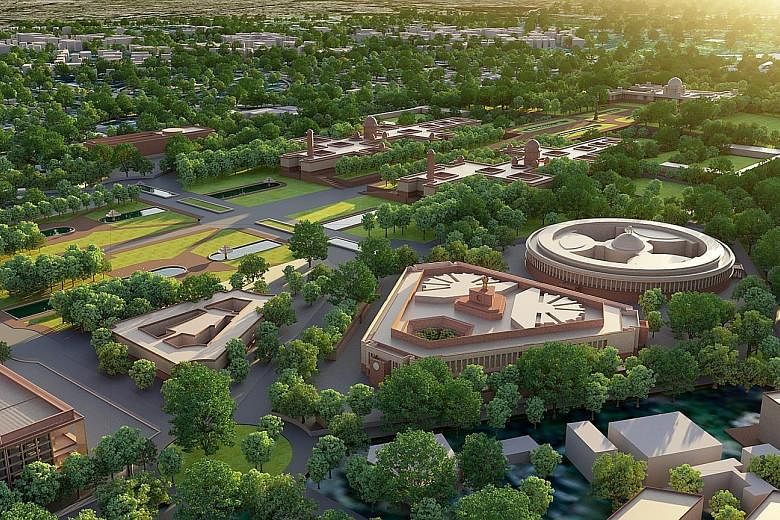A major project to revamp the iconic area housing India's major government structures has come under fire for its cost as well as its plans to construct a second Parliament and other new buildings.
The Central Vista revamp, estimated to cost the country 200 billion rupees (S$3.8 billion), is seen as a legacy project by Prime Minister Narendra Modi, but has been labelled a vanity project by critics.
Plans for the revamp, kicking off with a new Parliament building, have continued uninterrupted even as most economic activities have been on hold due to a lockdown over the coronavirus outbreak.
Measures aimed at reducing the spread of Covid-19 have been slowly easing, but will last until at least the end of the month.
The Environment Ministry on May 1 cleared the way for the construction of a new triangular Parliament building, next to the existing 93-year-old British-era structure, at a cost of 9.22 billion rupees.
Civil society groups, retired bureaucrats and opposition parties have objected to the ambitious revamp, questioning why the government is going ahead with it, particularly at a time of great economic distress. There was opposition to the plan even before the pandemic.
The pandemic has triggered massive job losses, stunted economic growth and forced hundreds of thousands of migrant workers to return home from the cities due to food and money shortages.
Ms Kanchi Kohli, an environmental governance expert with the Centre for Policy Research, said: "The present proposal of creating a new Parliament building and government central secretariat should neither be a matter of urgency or a priority. While the pandemic has thrown open the question of where expenditures should be directed, the Central Vista project is being questioned on many other grounds."
Critics have expressed concerns that the revamp will destroy the look of India's most iconic part and encroach on its green spaces.
Mr Sohail Hashmi, a writer and film-maker who conducts heritage walks in Delhi, said: "The so-called Central Vista redevelopment project was an absolutely unnecessary project when it was conceived. It was unnecessary and uncalled for from the heritage, architectural, environmental and aesthetic points of view."
The area stretches across nearly 3km, from India Gate to Rashtrapati Bhawan - the presidential palace.
The plans include demolishing several post-independence-era government buildings and building a Central Secretariat consisting of 10 buildings for all government offices.
There will also be a new residence and office for the Prime Minister.
The revamp will also see the North and South blocks, which house the Prime Minister's Office and other government offices, converted into museums, and a 20ha biodiversity arboretum carved out from the vast presidential estate.
The architect of the project has maintained that the plans will not dilute green spaces or change the iconic nature of Central Vista, where British-era sandstone structures combine a European style with Mughal influences.
Architect Bimal Patel, whose firm HCP Design, Planning and Management is handling the revamp, said: "The architecture of the new buildings will of course be modern - rational, functional and true to contemporary construction material and techniques. It will also be akin to the much-loved colonial buildings and resonate with them without imitating them. In addition, the placement, shape and size of all the new buildings will preserve the formal order and symmetry of the original Central Vista."
He added: "The proposed redevelopment aims to expand and modernise government facilities on the vista to make them efficient, technologically advanced and environmentally sustainable."
The government has been looking at India's 75th Independence Day, in 2022, as a deadline, but has yet to release any revised completion date.
The area is deeply tied to the country's history. Delhi was the capital of the Mughal Empire during the rule of Emperor Shah Jahan, from 1628 to 1658, and then again from 1911, when the British moved the capital from Kolkata.
The area is called Lutyens' Delhi after Sir Edwin Lutyens, the British architect who planned the capital city during British rule and designed the North Block, South Block and Parliament House.
A case is also pending in the Supreme Court on a technical issue of changing land use to start construction, but the court has not halted the project.
Around 60 retired bureaucrats, in an open letter to Mr Modi and Federal Housing and Urban Affairs Minister Hardeep Singh Puri, said the existing Parliament building can be modernised and expanded.
They also noted that it seemed "particularly irresponsible" to go ahead with the revamp at a time of economic distress.

